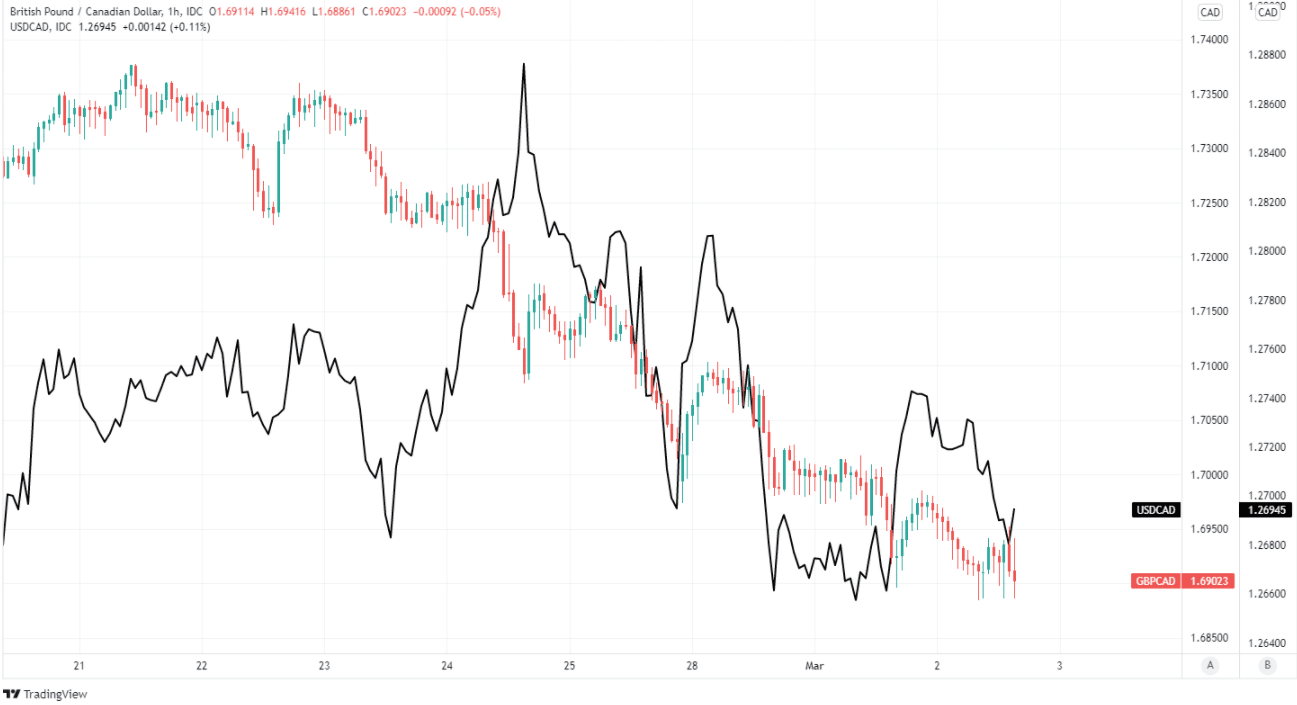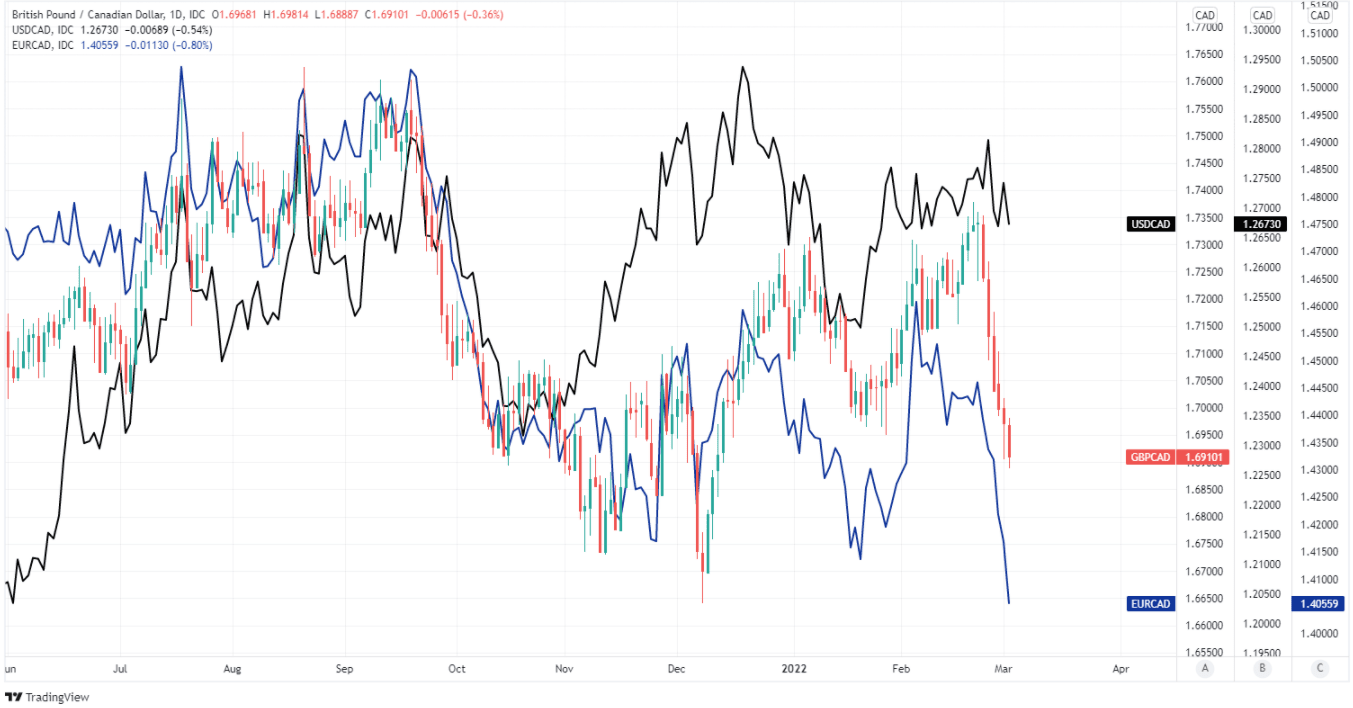Pound / Canadian Dollar Rate Finds Feet after BoC’s Cautious Liftoff
- Written by: James Skinner
-
- GBP/CAD finding feet near 1.69 after BoC liftoff
- BoC takes first step toward policy normalisation
- Acknowledges robust North American economy
- But warns of uncertainties & risks from Ukraine
- USD/CAD climbs & places floor under GBP/CAD

Above: BoC Governor Macklem. Image © Bank of Canada, Reproduced Under CC Licensing.
The Pound to Canadian Dollar rate steadied near 2022 lows after the Bank of Canada (BoC) took a cautious first step on the pathway toward monetary policy normalisation when lifting its cash rate for the first time since the onset of the coronavirus crisis.
Governing Council members voted on Wednesday to lift the BoC’s cash rate from 0.25% to 0.50% in what was a widely anticipated decision.
The Bank was quick to warn in the accompanying statement that Russia’s unprovoked invasion of Ukraine will raise inflation and have other negative implications that could darken the global economic outlook.
“Negative impacts on confidence and new supply disruptions could weigh on global growth. Financial market volatility has increased. The situation remains fluid and we are following events closely,” the statement reads in part.
While the BoC reiterated that “interest rates will need to rise further,” it said nothing that would encourage financial markets to alter their existing assumptions about the outlook and left much to be determined by its next round of economic forecasts due to be published in April.
“With the CPI likely to run hotter than we had expected through the first half of the year, odds are that the Bank will deliver the remaining three quarter point hikes we had allocated for 2022 over the next three rate setting dates, rather than spread out through the year. We expect it to then pause at a 1.25% overnight rate to take stock of the direction for growth and inflation,” says Avery Shenfeld, chief economist at CIBC Capital Markets.
Above: Pound to Canadian Dollar rate shown at hourly intervals alongside USD/CAD.
- Reference rates at publication:
GBP to CAD spot: 1.6925 - High street bank rates (indicative): 1.6333 - 1.6451
- Payment specialist rates (indicative: 1.6773 - 1.6840
- Find out about specialist rates and service, here
- Set up an exchange rate alert, here
While the prospect of a global economic slowdown is also a potential headwind to Canadian economic growth, the BoC noted in its March decision that domestic economic growth had been much stronger than was envisaged in the last forecast and acknowledged momentum had also appeared to be faster in the opening quarter of the new year than was so-far expected.
Given this, and the fact that “price increases have become more pervasive, and measures of core inflation have all risen,” further interest rate rises are viewed as necessary and will likely be accompanied at some stage by a decision to begin the process known as “quantitative tightening.”
The latter would see the BoC gradually exiting the government bond market by ceasing the reinvestment of proceeds it receives from the government each time an existing bond held on its balance sheet reaches maturity.
That’s just one of the steps necessary for the BoC to withdraw the extraordinary monetary stimulus provided to Canada’s economy since the onset of the coronavirus pandemic.
“We’ve yet to see a topic for Governor Macklem’s economic progress report tomorrow but think he could use the speech to provide more details on what QT will look like,” says Josh Nye, a senior economist at RBC Capital Markets.
{wbamp-hide start}
{wbamp-hide end}{wbamp-show start}{wbamp-show end}
The BoC bought up more than 40% of Canadian government bonds on the market during the acute phase of the coronavirus crisis in a bid to force down bond yields and in the process ensure that its significant interest rate cuts were passed on to a larger extent than otherwise.
This was after cutting Canada’s cash rate from 1.75% to 0.25% in March 2020.
“While the prospects of further hikes should support CAD on some crosses, we don't expect much follow-through in the short run. Much of the good news is priced in, and CAD now screens as one of the most overbought (tactically overvalued) currencies on our dashboard globally. Accordingly, we have taken profits on short GBPCAD,” says Mark McCormick, global head of FX strategy at TD Securities.
McCormick and the TD team had been sellers of GBP/CAD from last Wednesday when it was trading around 1.7243 although they booked profits on the trade this Wednesday when buying back Sterling around 1.6904.
This was due in large part to the broader financial market response to an ongoing incremental surge that has taken some oil prices back above $100 per barrel for the first time since 2014 as a result of the Russian military assault on Ukraine.
Above: Pound to Canadian Dollar rate shown at daily intervals alongside USD/CAD.
Secure a retail exchange rate that is between 3-5% stronger than offered by leading banks, learn more.
The nascent rally in oil has seen the oil-linked Canadian Dollar quickly become a favourite speculative bet among traders, and even more so given the BoC is just beginning to embark upon a process of monetary policy normalisation that could see Canadian interest rates rising further in months ahead.
Canada’s Dollar hasn't, however, responded in a meaningful way to the above referenced increase in prices and strategists at BMO Capital Markets offered insight on Wednesday as to why this might be.
“This type of slow adjustment of CAD to oil shocks is nothing new. When oil is perceived to have spiked temporarily, CAD usually only follows reluctantly after the oil move has shown a bit of resilience. So on that front, we think that if WTI were to stay above $100 for 2W or so, or alternatively, if WCS were to stay in the $90s for that interval, then we think it would be enough to fuel a run in EURCAD down below 1.4000 and perhaps to our 1.39 target,” says Stephen Gallo, European head of FX strategy at BMO.
“The other key point regarding why CAD has been so reluctant to rally alongside oil is the belief that the Alberta oil patch won't attract any foreign direct investment regardless of what happens to the oil price. And without a pipeline to get Alberta's carbons to sea, that is a fairly rational view. However, as noted [previously], there is renewed pressure on the Biden Administration to reconsider permitting the Keystone XL pipeline. We tend to doubt he will bend to that pressure, but we also wouldn't rule it out,” Gallo added.
The Canadian Dollar was little changed against the U.S. Dollar during the week to Wednesday but it had risen significantly against the Pound, Euro and other currencies in Europe, although these latter performances have been largely a reflection of losses sustained by European currencies as a result of events in Ukraine.













